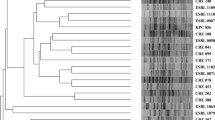Summary
New plasmidic β-lactamases inactivating so far stable cephalosporins, aztreonam and cephamycins restrict the use of these antibiotics in therapy of infections, e.g., byEscherichia coli and Klebsiella. Thus, combinations of β-lactamase inhibitors and β-lactam antibiotics were investigatedin vitro with regard to their therapeutic perspectives. Minimal inhibitory concentrations and the kinetics of killing in a pharmacodynamic model were determined. Extended broad spectrum betalactamases (EBS-β-lactamases) representative both for the TEM- and SHV-type were included. None of the available fixed combinations of penicillins and β-lactamase inhibitors appears useful for therapy of infections caused by producers of EBS-β-lactamases. In contrast, combinations of piperacillin and tazobactam or sulbactam plus cephalosporins (cefoperazone, cefotaxime, ceftazidime) or aztreonam are highly active (both by their MICs and bactericidal activity) against TEM-type EBS-β-lactamases, but less promising for the SHV-type EBS-β-lactamases, and plasmidic cephamycinase. Of the β-lactams available, the monobactam carumonam and the carbapenems (imipenem, meropenem) remain safe in infections caused byE. coli and Klebsiella EBSBase producers.
Zusammenfassung
Neue plasmid-kodierte β-Laktamasen inaktivieren bisher stabile Cephalosporine, Aztreonam und Cephamycine. Sie schränken damit die therapeutische Sicherheit dieser Antibiotika bei Infektionen zum Beispiel durchEscherichia coli oder Klebsiellaarten ein. Deshalb wurden die therapeutischen Perspektiven von Kombinationen aus β-Laktamase-Inhibitoren und β-Laktam-Antibiotikain vitro analysiert. Die minimalen Hemmkonzentrationen (MHK) wurden gemessen. Zu einem pharmakokinetischen Modell wurde die Abtötungskinetik bestimmt. Einbezogen wurden Enzyme sowohl aus der TEM- als auch der SHV-Reihe. Keine der beiden zugelassenen festen Kombinationen aus Penicillinen und β-Laktamase-Inhibitoren erwies sich als erfolgversprechend für die Therapie von Infektionen durch Stämme, welche β-Laktamasen mit erweitertem Spektrum produzieren. Demgegenüber waren Kombinationen aus Piperacillin und Tazobactam oder Sulbactam mit Cephalosporinen (Cefoperazon, Cefotaxim, Ceftazidim) oder Aztreonam sowohl aufgrund ihrer MHK-Werte als auch ihrer bakteriziden Aktivität im pharmakodynamischen Modell hochaktiv gegenüber TEM-β-Laktamasen mit erweitertem Spektrum, jedoch weniger wirksam bei Stämmen mit neuen Enzymen der SHV-Reihe und plasmid-kodierter Cephamycinasen. Unter den derzeit vorhandenen β-Laktam-Antibiotika kommt anhand ihrerIn-vitro-Aktivität dem Monobactam Carumonam sowie den Carbapenemen (Impipenem, Meropenem) auch ohne β-Laktamase-Inhibitor die größte therapeutische Sicherheit bei Infektionen durchE. coli und Klebsiella-Stämme mit der Fähigkeit zur Synthese von β-Laktamasen mit erweitertem Spektrum zu.
Similar content being viewed by others
References
Philippon, A., Labia, R., Jacoby, G. Extended spectrum β-lactamases. Antimicrob. Agents Chemother. 33 (1989) 1131–1136.
Bauernfeind, A., Chong, Y., Schweighart, S. Extended broad spectrum β-lactamase inKlebsiella pneumoniae including resistance to cephamycins. Infection 17 (1989) 50–55.
Bauernfeind, A., Hörl, G. Novel R-factor borne β-lactamase ofEscherichia coli confering resistance to cephalosporins. Infection 15 (1987) 257–259.
Sirot, D., Sirot, J., Labia, R., Morand, A., Courvalin, P., Darfeuille-Michaud, A., Perroux, R., Cluzel, R. Transferable resistance to third-generation cephalosporins in clinical isolates ofKlebsiella pneumoniae: identification of CTX-1, a novel β-lactamase. J. Antimicrob. Chemother. 20 (1987) 323–334.
Petit, A., Sirot, D. L., Chanal, C. M., Sirot, J. L., Labia, R., Gerbaud, G., Cluzel, R. A. Novel plasmid-mediated β-lactamase in clinical isolates ofKlebsiella pneumoniae more resistant to ceftazidime than to other broad-spectrum cephalosporins. Antimicrob. Agents Chemother. 32 (1988) 626–630.
Gutmann, L., Kitzis, M. D., Billot-Klein, D., Goldstein, F., Tran Van Nhieu, G., Lu, T., Carlet, J., Collatz, E., Williamson, R. Plasmid-mediated β-lactamase (TEM-7) involved in resistance to ceftazidime and aztreonam. Rev. Infect. Dis. 10 (1988) 860–866.
Shah, P. M., Stille, W. Escherichia coli andKlebsiella pneumoniae strains more susceptible to cefoxitin than to third generation cephalosporins. J. Antimicrob. Chemother. 11 (1983) 597–601.
Bauernfeind, A., Shah, P., Petermüller, C., Motz, M.: Plasmid-determined resistance to third generation cephalosporins in Enterobacteria. IV Mediterranean Congress of Chemotherapy (1984). Proceedings 30–31.
Buré, A., Legrand, P., Arlet, G., Jarlier, V., Paul, G., Philippon, A. Dissemination in five French hospitals ofKlebsiella pneumoniae serotype K25 harbouring a new transferable enzymatic resistance to third generation cephalosporins and aztreonam. Eur. J. Clin. Microbiol. 7 (1988) 780–782.
Gutmann, L., Ferré, B., Goldstein, F. W., Rizk, N., Pinto-Schuster, E., Acar, J. F., Collatz, E. SHV-5, a novel SHV-type β-lactamase that hydrolyzes broad-spectrum cephalosporins and monobactams. Antimicrob. Agents Chemother. 33 (1989) 951–956.
Bauernfeind, A., Jungwirth, R. Simulation of serum pharmacokinetics of two drugs in a liquid culture ofPseudomonas aeruginosa and analysis of their inactivating activity. Chemotherapy 28 (1982) 334–340.
Beecham-Wülfing: Standard-Information für den Krankenhausapotheker zum Fertigarzneimittel Augmentan® i.v. (1984).
Foulds, G. Pharmacokinetics of sulbactam/ampicillin in humans: a review. Rev. Infect. Dis. 8, Suppl. 5 (1986) 503–506.
Foulds, G., Stankewich, J. P., Marshall, D. C., O'Brien, M. M., Hayes, S. L., Weidler, D. J., McMahon, F. G. Pharmacokinetics of sulbactam in humans. Antimicrob. Agents Chemother. 23 (1983) 692–699.
Cyanamid: Pharmacodynamic research (1988).
Craig, W. A. Single-dose pharmacokinetics of cefoperazone following intravenous administration. Clin. Therapeutics 3 (1980) 46–49.
Drusano, G. L., Standiford, H. C., Fitzpatrick, B., Leslie, J., Tangtatsawasdi, P., Ryan, P., Tatem, B., Moody, M. R., Schimpff, S. C. Comparison of the pharmacokinetics of ceftazidime and moxalactam and their microbiological correlates in volunteers. Antimicrob. Agents Chemother. 26 (1984) 388–393.
Bauernfeind, A. Comparativein-vitro activity of SCH 34343, impenem, cefpirome and cefotaxime. J. Antimicrob. Chemother. 15, Suppl. C (1985) 155–164.
Brun-Buisson, C., Legrand, P., Philippon, A., Montravers, F., Ansquer, M., Duval, J. Transferable enzymatic resistance to third-generation cephalosporins during nosocomial outbreak of multiresistantKlebsiella pneumoniae. Lancet ii (1987) 302–306.
Thabaut, A., Acar, J., Arlet, G., Berardi-Grassias, L., Bergogne-Bérézin, E., Brun, Y., Buisson, Y., Chabanon, G., Cluzel, R., Courtieu, A., Dabernat, H., Duval, J., Fleurette, J., Ghnassia, J. C., Jarlier, V., Meyran, M., Monteil, H., Petithory, J. C., Philippon, A., Sedallian, A., Sirot, J., Viot, M., Werneburg, B. Sensibilité dePseudomonas aeruginosa et des Klebsiella à la ceftazidime. Presse Méd. 17 (1988) 1895–1899.
Brun-Buisson, C., Legrand, P., Raus, A., Richard, C., Montravers, F., Besbes, M., Meakins, J. L., Soussy, C. J., Lemaire, F. Intestinal decontamination for control of nosocomial multiresistant gramnegative bacilli. Ann. Intern. Med. 110 (1989) 873–881.
Author information
Authors and Affiliations
Additional information
Symposium 2nd Biennial Conference on Chemotherapy of Infectious Diseases and Malignancies, Montreux, March 5th–8th, 1989.
Supported by Pfizer GmbH, Karlsruhe, FR Germany.
Rights and permissions
About this article
Cite this article
Bauernfeind, A. Perspectives of beta-lactamases inhibitors in therapy of infections caused by Escherichia coli or Klebsiella with plasmidic resistance to third generation cephalosporins. Infection 18, 48–52 (1990). https://doi.org/10.1007/BF01644185
Issue Date:
DOI: https://doi.org/10.1007/BF01644185




